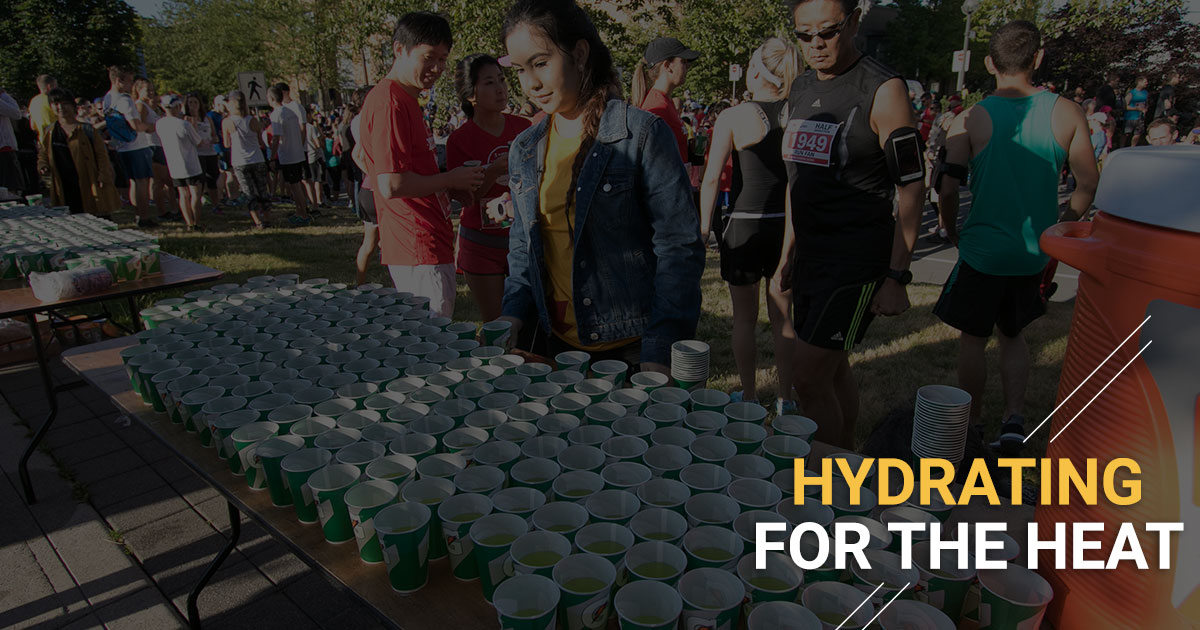
As the weather improves, hydration becomes increasingly important. During the winter months runners forget that even though it’s cold outside, they’re still sweating and losing water/electrolytes on their runs. When spring and summer hits, our sweat loss is more apparent and makes people more aware of their rehydration tactics.
It’s hard to know how much to drink, when to drink what, and how to rehydrate appropriately. Here are some tips to keep you on track:
- Don’t wait until you’re thirsty. It’s important to continually sip water or another low-calorie drink options throughout the day to keep your hydration levels up. Carry a water bottle with you wherever you go so you’re constantly getting fluids in. Not only will it help on your run, it will keep you alert during the day and can help to avoid the mid-afternoon headache that can occur if you aren’t well hydrated. Plus it helps your digestion, it keeps you moving when getting up to use the bathroom, and does wonders for your skin.
- Use your urine as your hydration indicator. Keeping tabs on the colour of your urine sounds bizarre but it’s the easiest way to determine how hydrated/dehydrated you are. The goal is to have a light yellow colour, kind of like the colour of lemonade. It shows that you’re hydrated but still have electrolytes moving through the body (they cause the yellow colour). If your urine is totally clear, you’re probably drinking too much. If it’s a dark yellow, you’re probably in need of some extra fluids. If it’s taking on the colour of iced tea, you definitely need some water as that’s a warning sign for dehydration.
- Drink before your run. That doesn’t mean you need to slam a liter of water right before you step out the door, but use the 1-2 hours before a run to get in some fluids. If you’re running as soon as you wake up, drink at least a glass of water before you run. Your body will have been deprived of water while you’re sleeping, so it’s important to get something down to help the body function. You’ll eventually figure our how much you can handle, but if your stomach sounds like a fishbowl with water sloshing around, you’ve probably had too much.
- During your run the amount you consume depends on how long you’re going for. If it’s a short run, you probably don’t need anything. If you’re worried you might need something, choose a route with water fountains along the way. If you’re out for a long run, you’ll need to have something along the way. If the idea of carrying a bottle for the entire run isn’t appealing, choose a route with fountains, or convenience stores along the way to make a pit stop. Water will help wash down any gels/chews you have to eat too. If you’re not taking in any fuel, use a sports drink to make sure you’re replenishing both the sugars and electrolytes that are lost through your sweat.
- After your run is when you can focus on replacing what you lost on the run. A good way of determining your water loss is by weighing yourself without clothes on before and after your run. Drinking a litre of fluids for every kilogram that’s lost is a general rule of thumb. You’ll likely drink more than the minimum required, but you’ll just pee out whatever your body doesn’t need. Be sure to add in some electrolytes to your water as it will help the body retain the fluid you’ve consumed. Chocolate milk is a great post-run drink as it not only has sugars and nutrients that rehydrate you, but it also has protein in it that will help rebuild your tired muscles.
With these things in mind, still be cautious on long runs in the heat. Try to get your run done in the morning to avoid the intense mid-day sun. If you’re feeling sick, seeing spots, or feel like you’re going to bonk, just stop. It’s not worth putting yourself at more risk than necessary. Carry money or a credit card and a piece of ID with you in case of emergency so people can help you accordingly.






